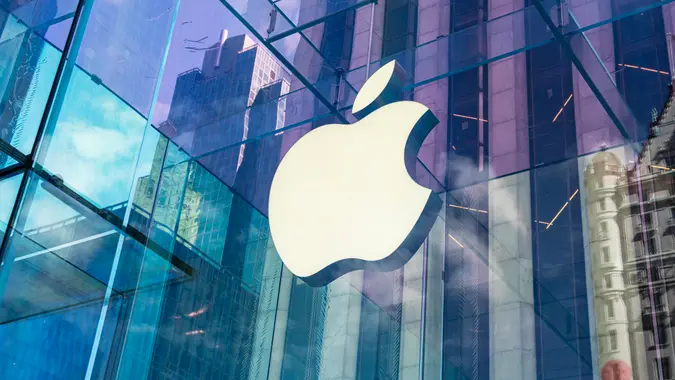Best High Dividend Stocks To Watch and Invest In Right Now

Commitment to Our Readers
GOBankingRates' editorial team is committed to bringing you unbiased reviews and information. We use data-driven methodologies to evaluate financial products and services - our reviews and ratings are not influenced by advertisers. You can read more about our editorial guidelines and our products and services review methodology.

20 Years
Helping You Live Richer

Reviewed
by Experts

Trusted by
Millions of Readers
If you’re looking to grow your money with less drama and more reliability, high-dividend stocks might be exactly what your portfolio needs. In 2025, many investors are turning to dividend-paying stocks for steady income, portfolio diversification and long-term growth potential. However, not all dividend stocks are created equal.
In this guide, we’ll break down the best high-dividend stocks to watch or invest in this year.
Whether you’re a beginner investor or just looking to boost your income stream, you’ll find clear, actionable insights to help you make smart investing decisions.
Best High-Dividend Stocks in 2025
Here are some top picks based on dividend yield, company strength and recent performance:
| Stock | Ticker | Market Cap | Dividend Yield | Current Share Price | Annual Dividend |
|---|---|---|---|---|---|
| AbbVie Inc. | ABBV | $313.43 Billion | 3.55% | $177.44 | $6.56 |
| Chevron | CVX | $245.37 Billion | 4.97% | $137.73 | $6.84 |
| Phillips Morris International | PM | $255.32 Billion | 3.11% | $173.17 | $5.40 |
| Home Depot | HD | $370.55 Billion | 2.41% | $379.25 | $9.20 |
| Coca Cola | KO | $297.68 Billion | 2.84% | $71.94 | $2.04 |
| American Electric Power | AEP | $52.67 Billion | 3.59% |
$103.78 |
$3.72 |
| Johnson & Johnson | JNJ | $352.15 Billion | 3.39% | $152.52 | $5.20 |
| Duke Energy | DUK | $91.2 Billion | 3.56% | $116.99 | $4.20 |
Bonus Pick: Vanguard High Dividend Yield ETF (VYM)
- A basket of reliable dividend payers
- Yield around 3% with built-in diversification
Why Invest in High-Dividend Stocks?
High-dividend stocks are appealing for many reasons. Here are four reasons to invest:
- Steady income stream: You usually receive a quarterly payment with high-dividend stocks.
- Indicates a healthy company: If a company is distributing dividends, this indicates that the company is doing well.
- A chance to reinvest: You can reinvest your dividends, which boosts long-term growth.
- Lower volatility: A high-dividend stock tends to have fewer dips during market downturns.
Remember, there are ways to make the most of your investments without overcomplicating the process. Automating your contributions and dividend reinvestments can take emotion out of the equation and help you stay consistent — even when the market fluctuates. Over time, consistency matters more than trying to time the market or chase the next big stock.
“The simpler you make it for yourself, the stronger your investment habits will be,” says Rodriguez Segarra, CFP, founder and CEO of Advise Financial. “If you have to overthink or follow a complicated series of steps to invest, it becomes harder.”
In other words, streamline your approach — set up automatic transfers, enroll in dividend reinvestment programs, and stick to a clear plan. The easier your system is to maintain, the more likely you are to stay disciplined and see meaningful long-term growth.
High-Dividend Stocks vs. Other Investment Options
How do high-dividend stocks compare to other investments? Check out this chart that compares high-dividend stocks with other investment options.
| Investment Type | Pros | Cons |
|---|---|---|
| High-dividend stocks | -Regular income -Ideal for retirees -Lower volatility |
-Dividend cuts could happen -Sensitive to interest rate changes -Slower capital appreciation |
| Growth stocks | -Strong earnings growth -Ideal for compounding -High upside |
-Often no dividends -High volatility -Valuation risk |
| Non-dividend stocks | -Generally strong returns -Low fees -Diversified exposure |
-Market dependent -Lower short-term gains -Lacks specific sector upside |
| ETFs | -Good diversification opportunity -Easy to invest and manage |
-Fees for management -Less control over holdings |
| Real Estate (REITs) | -Regular income -Inflation hedge |
-Speculative -Regulatory concerns |
Risks of Investing in High-Dividend Stocks
Do high-dividend stocks carry any risks? Every investment has its inherent risks. There are three risks with high-dividend stocks:
- Dividends can be cut or reduced: If a company is experiencing financial upheaval, dividends can be slashed.
- Subject to interest rate fluctuations: When interest rates are high, certain high-dividend stocks tend to underperform.
- Could be a yield trap: A high dividend sometimes means a company’s stock price has dropped because of financial instability.
Trends Shaping Dividend Stocks in 2025

Here’s what’s moving the needle in this space right now:
- Interest Rate Stabilization: As the Fed holds or potentially cuts rates, dividend stocks regain appeal.
- REIT Recovery: Real estate stocks like Realty Income are rebounding with consumer foot traffic.
- Energy Sector Momentum: Companies like ExxonMobil benefit from global demand and rising oil prices.
- Tech Dividends Rising: More tech giants are adding or increasing dividends to appeal to long-term holders.
Stay tuned to earnings reports and dividend announcements — they’re key indicators of where these stocks are heading.
How to Buy High-Dividend Stocks
It makes sense to open a brokerage account even before you’ve decided what dividend stocks to invest in.
The major brokerages give account holders access to a wealth of educational resources and research to help them explore their options.
- Step 1: Select a brokerage to invest with – GOBankingRates’ 10 Best Stock Brokers rankings can help you choose.
- Step 2: Decide whether to get a self-directed account that lets you select your own investments, a robo-advisor account that builds a portfolio for you or a traditional brokerage account with an advisor to select and execute your trades.
- Step 3: From the brokerage website, click the link or button to open an account and follow the prompts to submit your information.
- Step 4: Fund your account per the application’s instructions, or hold off until you’re ready to invest.
Should You Chase High Dividend Yields or Long-Term Dividend Growth?
When comparing dividend stocks, it’s important to know that high yield isn’t always better. Investors generally choose between two strategies — high-dividend yield and dividend growth — each with its own trade-offs.
- High-Yield Stocks. These companies, such as REITs or utility stocks, pay out a larger portion of their profits in dividends right now. The benefit is immediate income, which can appeal to retirees or investors seeking steady cash flow. The drawback is that high-yield companies often have less room for long-term growth and can be more sensitive to interest rate changes.
- Dividend Growth Stocks. Often called Dividend Aristocrats, these are established companies that consistently raise their payouts year after year. Yields might start lower, but those dividends can grow faster than inflation — helping your income increase steadily over time.
So while high yield offers more income today, dividend growth can deliver more stability and compounding tomorrow. A balanced portfolio often includes a mix of both.
How To Spot Sustainable Dividend Stocks
A high yield means little if the company can’t maintain it. To separate reliable dividend payers from potential “yield traps,” look at a few key financial metrics:
- Payout Ratio. Shows how much of a company’s earnings go toward dividends. A ratio below 60% is typically healthy — it means the company keeps enough profits to reinvest and grow.
- Dividend Coverage Ratio. Measures how easily earnings can cover dividend payments. A coverage ratio above 2 suggests the company earns at least twice what it pays out, signaling strong stability.
- Free Cash Flow (FCF). Indicates how much real cash remains after expenses. Positive and growing FCF means the company can sustain or even raise dividends without taking on debt.
Investors who focus on these metrics often find steady, resilient dividend stocks that can weather market ups and downs while continuing to reward shareholders.
The Power of Reinvesting Dividends
Reinvesting your dividends can make a huge difference in long-term growth. Instead of taking cash payouts, you use them to buy more shares — which then earn even more dividends.
Here’s a quick example:
- Invest $10,000 in dividend-paying stocks with a 3% yield and 7% average annual growth.
- After 30 years, your balance grows to about $76,000 if you reinvest your dividends.
- Without reinvesting, you’d have roughly $57,000 — nearly $19,000 less.
That’s the power of compounding. The longer you hold and reinvest, the faster your portfolio can snowball.
Pro Tip
Many brokerages let you set up automatic dividend reinvestment (called a DRIP), so your dividends buy more shares instantly — no extra steps required.
Final Take: The Best High-Dividend Stocks To Build Wealth in 2025
The best high-dividend stocks in 2025 offer more than just a paycheck — they bring consistency, protection against inflation and a way to build wealth over time. Whether you’re new to investing or just looking to rebalance, these stocks (and ETFs) deserve a spot on your radar.
Take the next step: compare dividend yields, look into sector trends and start small. Remember, it’s not about chasing the highest yield — it’s about choosing quality companies with staying power.
For more help, check out our beginner investing guide and how to buy ETFs to build a confident foundation.
FAQs
Here are the answers to some of the most frequently asked questions regarding the best high-dividend stocks to invest in ASAP:
-
What are the best high-dividend stocks for beginners?
- Johnson & Johnson (JNJ), PepsiCo (PEP), Coca-Cola (KO) and Verizon (VZ) are good high-dividend stocks for beginners.
-
Should I invest in high-dividend stocks in 2025?
- It depends on your goals. If you'd like long-term stability, steady income and minimal volatility, high-dividend stocks can be a smart investment for 2025.
-
Which stocks pay dividends?
- AT&T (T), Verizon (VZ), Chevron (CVX) and Pfizer (PFE) are well-known dividend-paying stocks.
-
Are high-dividend stocks good for long-term growth?
- Yes. Reinvested dividends can compound over time, boosting total returns. High-dividend stocks also tend to have lower volatility and promote stability.
Information is accurate as of Oct. 8, 2025.
Editorial Note: This content is not provided by any entity covered in this article. Any opinions, analyses, reviews, ratings or recommendations expressed in this article are those of the author alone and have not been reviewed, approved or otherwise endorsed by any entity named in this article.
Our in-house research team and on-site financial experts work together to create content that’s accurate, impartial, and up to date. We fact-check every single statistic, quote and fact using trusted primary resources to make sure the information we provide is correct. You can learn more about GOBankingRates’ processes and standards in our editorial policy
- Forbes. 2020. "How To Score Big With Dividend Stocks In 2021."
- Forbes Advisor. 2021. "Investing Basics: What Are Dividends?"
- Forbes Advisor. 2021. "How To Calculate Dividend Yield."
- IRS. 2022. "Topic No. 404 Dividends."
- Finviz. "Financial Visualizations"
- Yahoo Finance. "Yahoo Finance."
- Realty Income. 2023. "122nd Common Stock Monthly Dividend Increase Declared by Realty Income"
- Office of Financial Readiness. "Investing Basics: Bonds, Stocks, Mutual Funds and ETFs."
 Written by
Written by  Edited by
Edited by 

























